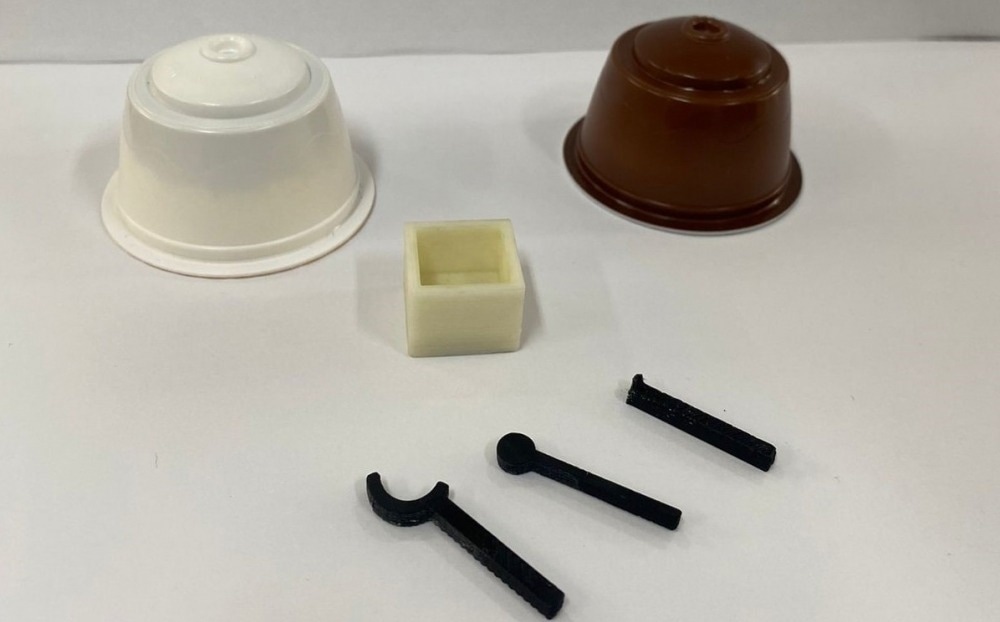The plastic in used coffee pods can be recycled to generate filament for 3D printers, reducing their environmental impact, according to an article published in the journal ACS Sustainable Chemistry & Engineering.
 Tested by Brazilian and British researchers, the process is an example of circular economy technology, in which waste produced in one economic activity is converted into resources for other sectors. Photo: used pods and examples of parts produced by 3D printing, also called additive manufacturing. Image Credit: Bruno Campos Janegitz/UFSCar.
Tested by Brazilian and British researchers, the process is an example of circular economy technology, in which waste produced in one economic activity is converted into resources for other sectors. Photo: used pods and examples of parts produced by 3D printing, also called additive manufacturing. Image Credit: Bruno Campos Janegitz/UFSCar.
The approach was successfully tested by research teams at the Federal University of São Carlos (USFCar) and the State University of Campinas (UNICAMP) and in the United Kingdom at Manchester Metropolitan University (MMU).
We produced new conductive and non-conductive filaments from waste polylactic acid [PLA] from used coffee machine pods. There are many applications for these filaments, including conductive parts for machinery and sensors.
Bruno Campos Janegitz, Study Co-Author and Head, Sensors, Nanomedicine and Nanostructured Materials Laboratory, UFSCar
Brazil is the world’s leading producer and exporter of coffee, as well as the world’s second-largest consumer, trailing only the United States. Despite the fact that the majority of coffee consumed in Brazil is low-quality (Coffea canephora, also known as robusta coffee, with a high proportion of faults and impurities disguised by high roasting of beans and plenty of sugar or sweetener in the cup), demand for gourmet and specialty coffees are steadily increasing.
Gourmet coffees score 75–80 on the Brazilian Coffee Industry Association (ABIC) rating, which ranges from 0 to 100. They are made from chosen arabica beans (Coffea arabica) roasted to preserve their natural sugars, aroma, and flavor. Specialty coffees must also have a socio-environmental certification and a score of at least 80 on the Brazilian Specialty Coffee Association’s scale (BSCA).
The quality of the beverage is also determined by how it is prepared, and many Brazilians have begun to replace the traditional cloth or paper filter with a cafetière (also known as a French press) or stove-top Moka pot (caffettiera in Italian). Portable electric espresso machines that use pods are also becoming increasingly popular, albeit at a much higher price. The issue with the latter is determining what to do with used pods.
Even though reusable pods exist and some suppliers encourage the recycling of aluminum pods, most consumers simply discard used pods, especially if they are made of plastic. Considering all of the variables, estimates by the São Paulo State Technological Research Institute (IPT) demonstrate that “a cup of pod coffee can be as much as 14 times more damaging to the environment than a cup of filter coffee”.
To find new applications for this waste, the researchers created electrochemical cells with non-conductive PLA filaments and electrochemical sensors with conductive filaments made by adding carbon black to PLA. Carbon black is a paracrystalline form of carbon produced by incomplete hydrocarbon combustion.
“The electrochemical sensors were used to determine the proportion of caffeine in black tea and arabica coffee,” Janegitz explained.
He said that filament production is pretty straightforward.
We obtain the non-conductive material simply by washing and drying PLA pods, followed by hot extrusion. To obtain the conductive material, we add carbon black before heating and extrusion. The extruded material is then cooled and spooled to produce the filament of interest.
Bruno Campos Janegitz, Study Co-Author and Head, Sensors, Nanomedicine and Nanostructured Materials Laboratory, UFSCar
The process is a good illustration of the circular economy, in which trash generated by economic activity is changed into resources to implement another activity rather than being considered a problem that hurts the environment.
The polymer base obtained from used pods can generate devices with a great deal of added value.
Bruno Campos Janegitz, Study Co-Author and Head, Sensors, Nanomedicine and Nanostructured Materials Laboratory, UFSCar
Janegitz collaborated on the work with Cristiane Kalinke, a Ph.D. in analytical chemistry and Researcher at UNICAMP, while on a research internship abroad under the supervision of Craig Banks, an MMU Professor, and the article’s last author. FAPESP provided Janegitz with a Thematic Project and a research scholarship abroad. Kalinke received a scholarship for a research internship abroad.
Juliano Alves Bonacin, a UNICAMP Professor, also took part in the research.
Journal Reference:
Sigley, E., et al. (2023). Circular Economy Electrochemistry: Creating Additive Manufacturing Feedstocks for Caffeine Detection from Post-Industrial Coffee Pod Waste. ACS Sustainable Chemistry & Engineering. doi.org/10.1021/acssuschemeng.2c06514.